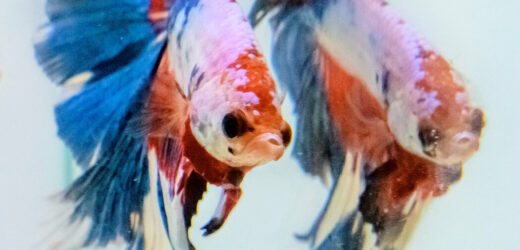For centuries, humans have been captivated by the beauty of the betta. Their slender bodies and oversized fins, which hang like bolts of silk, come in a variety of vibrant colors seldom seen in nature.
However, bettas, also known as the Siamese fighting fish, did not become living works of art on their own. The betta’s elaborate colors and long, flowing fins are the product of a millennium of careful selective breeding. Or as Yi-Kai Tea, a doctoral candidate at the University of Sydney who studies the evolution and speciation of fishes put it, “quite literally the fish equivalent of dog domestication.”
A new study, uploaded in April to the preprint service BioRxiv, shows through genome sequencing that humans began domesticating bettas at least 1,000 years ago. The millennium of careful selection gave rise to the stunning diversity of domestic betta fishes alive today, but also caused both wild and domestic betta fish to undergo vast genetic changes. By studying the genes of these fish, the study’s authors argue, scientists can learn a great deal about how domestication alters the genes of wild animals.
Mr. Tea, who was not involved in the analysis, praised the research for being “the first major study to tease apart the genetic basis for this remarkable phenomenon,” in fish, he said.
All 73 species of bettas originated in Southeast Asia. But the ubiquitous species sold in pet shops and at flea markets is Betta splendens. Domesticated bettas of this species are far more colorful than most wild species.
“Wild bettas can look very different from ornamental bettas,” said Young Mi Kwon, a researcher at Columbia University and lead author of the study. “They have short fins, duller coloration and lack the striking finnage that you can find in ornamental varieties.”
Domestic bettas are also “very aggressive,” she said. “You can’t put two betta males in the same tank, they will attack each other and will fight to the death.”
Wild bettas are far less aggressive. This is likely because the ornamental species “were initially domesticated for fighting, similar to cockfights,” Ms. Kwon said.
By the end of the 19th century, breeders began focusing on creating ornamental varieties of the fish, which had become extremely popular in the West. “This history has shaped the ornamental bettas we see today — a really beautiful fish with a temper,” she said.
To determine exactly how this history shaped the ornamental bettas we see today, Ms. Kwon and a team of scientists collected DNA samples from wild and domestic betta and sequenced their genomes.
“We were surprised by how long bettas have been part of human history — it’s been domesticated for at least 1,000 years, making it one of the oldest fish domestications known,” said Ms. Kwon. That is further back than earlier anecdotal research cited in the study suggesting that bettas had been bred for fighting as early as the 13th century.
The research also highlighted why breeders have been able to create dozens of different varieties of betta. There are red, yellow and blue bettas, bettas with big fins and small fins and even bettas that resemble Thailand’s flag. If you can imagine it, it probably exists.
“Many of the traits that breeders are selecting are regulated by very few genes that have a major effect,” Ms. Kwon said. “This means it doesn’t take that extensive a number of crosses to get the trait or traits that you want for your fish.”
As expected, the researchers also discovered that domestic bettas are genetically dissimilar to their wild cousins. However, they were surprised to find that, in past and recent years, domestic bettas have interbred with wild ones. This hybridization, which was likely the result of domestic bettas being released into the wild, could undermine conservation efforts.
“Feral domestics — if they are more fit than their wild counterparts — can take over the wild populations,” Ms. Kwon said. Many wild species of betta are threatened with extinction, mainly as a result of habitat loss.
By studying the evolutionary history of these fish in greater detail, the researchers hope to improve our understanding of how domestication alters the genes of species.
Although there is still much to be learned about how domestication is affecting bettas, the process has produced a plethora of pretty fish whose fantastical colors and shapes may never have existed otherwise.
Bettas as extravagant as the domestic variety “are unlikely to occur in the wild,” Mr. Tea said. “It’s like expecting chihuahuas to naturally exist in the wild without human interference.”
Source: Read Full Article


